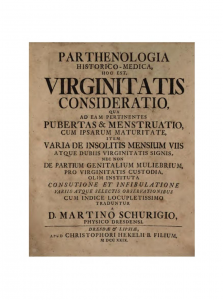 Historical accounts of ‘male menstruation’ have already been discussed on this blog by Lisa Smith. But there is another aspect of the history of menstruation that is fascinating to a modern reader: the phenomenon of ‘vicarious menstruation’, in which a woman bleeds regularly from another orifice, or even from a wound. While modern medicine still recognises conditions in which other mucous membranes bleed along with, or instead of, the womb lining, the cases from the past seem to be well outside what is thought to be possible today. I think this is one of those occasions on which attempts to diagnose the diseases of the past with modern disease labels just have to admit defeat. The belief in such diversion being possible goes back to the Hippocratic medical texts, which state that a nosebleed is a good thing if menstruation is suppressed.
Historical accounts of ‘male menstruation’ have already been discussed on this blog by Lisa Smith. But there is another aspect of the history of menstruation that is fascinating to a modern reader: the phenomenon of ‘vicarious menstruation’, in which a woman bleeds regularly from another orifice, or even from a wound. While modern medicine still recognises conditions in which other mucous membranes bleed along with, or instead of, the womb lining, the cases from the past seem to be well outside what is thought to be possible today. I think this is one of those occasions on which attempts to diagnose the diseases of the past with modern disease labels just have to admit defeat. The belief in such diversion being possible goes back to the Hippocratic medical texts, which state that a nosebleed is a good thing if menstruation is suppressed.
In 1838 the physician Fleetwood Churchill described a case a colleague had seen: Mary Murphy, aged 21, a patient at Sir Patrick Dun’s teaching hospital in Dublin. ‘During her stay she missed a menstrual period, and was shortly afterwards attacked by hemorrhage from both ears, which was repeated at intervals of from three to five nights, each attack lasting some hours. Very often from 15 to 20 ounces of blood were collected which did not coagulate, neither did blood taken from the arm.’ 15-20 ounces: that’s half a litre. Today we see a ‘normal’ period as being around 80 millitres or 3 fluid ounces! She was treated by ‘strengthening her system’, with foot baths, purgative medicines, and also leeches. The leeches were applied behind her ears and on her inner thighs, to take the blood before it came out, and to divert it back down her body.
The high point of belief in such bleeding was Martin Schurig’s Parthenologia historico-medica (1729), which brought together a huge range of cases from the sixteenth and seventeenth centuries to include menstruation through the ears, skin, gums, saliva glands, tear ducts, the crown of the head, fingers, feet, the stomach and lungs, the bladder, the bowels, the back, the navel, and even a cut on the hand, because ‘Nature searches for an exit route for the menstrual blood’. Physicians noted that the first reaction of a physician when confronted with ‘a delicate female’ suffering from such bleeding may be ‘alarm and anxiety’. What about the reactions of the patients, I wonder?
In the UK, ‘vicarious menstruation’ was only really challenged in the late 1880s, when the British Gynaecological Society discussed a paper by Dr Robert Barnes entitled ‘On vicarious menstruation’ which defended the theory of the blood taking the path of least resistance if ‘the normal route fails’. My late grandmother was born in 1888 and it is amazing to think that such a theory lasted so long!
– if you want to know more about Fleetwood Churchill, see http://rcpilibrary.blogspot.com/2010/10/cataloguing-fleetwood-churchill.html
